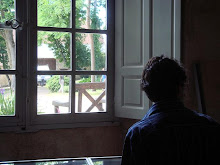The Ladder of Divine Ascent
 This is a 12th century Byzantine icon of The Ladder of Divine Ascent. I came across it during my visit to the Byzantine art exhibition in the Royal Academy. I couldn't help but smile the first time I set my gaze upon the unfortunate monks ingloriously falling from it, pulled downwards by the symbolic demons representing their vices. It is quite amusing at first sight due to the way the falling figures are portrayed - their bodies turned completely upside-down, damning them irrevocably. Funnily enough, it all looks like an episode from a children's comic series, but it was seriously intended to visually present the metaphorical ladder of ascent to God's Kingdom so as to 'educate' the monks at the Sinai Monastery.
This is a 12th century Byzantine icon of The Ladder of Divine Ascent. I came across it during my visit to the Byzantine art exhibition in the Royal Academy. I couldn't help but smile the first time I set my gaze upon the unfortunate monks ingloriously falling from it, pulled downwards by the symbolic demons representing their vices. It is quite amusing at first sight due to the way the falling figures are portrayed - their bodies turned completely upside-down, damning them irrevocably. Funnily enough, it all looks like an episode from a children's comic series, but it was seriously intended to visually present the metaphorical ladder of ascent to God's Kingdom so as to 'educate' the monks at the Sinai Monastery.But when I look at the nasty black demons I am struck by their position within the image itself. Some of them are fairly high up, yet do they need a ladder to elevate themselves to such heights? No, it seems - they are floating freely in the air, parading around in weightlessness. They don't need a ladder - their cunning is enough to defy gravity and send them up closer to the heavenly Christ than many of the monks, whose journey up is toilsome and time consuming.
The sheer ease with which these demons move within the picture , their implied subtle movements - this is where the true seriousness of the image shows up. The demons are seemingly able to reach certain heights without the help of the ladder - they evade its 'righteous' path.
I am sure I am delving into certain metaphorical depths within the icon beyond which the painter initially intended, but a question invariably pops up nevertheless: how many people have tried to reach Christ in that very same way?
I smile, apologetically this time, and blush.


2 Comments:
I don't claim to have reached Christ, but as the Romans used to say, ex malo bonum. When we acknowledge certain necessary evils in ourselves, we can strive for good in all honesty without being hypocrites.
Yep. I think it's always sad when one is being denied the chance to be honest to oneself even if one is not a hundred percent honest to others. Going against our nature for whatever reason is at the root of those 'certain evils' which thus become an inevitable and all too natural necessity because we are forced to abide an alien moral code belonging to someone else, and especially for a man, this is profoundly devastating.
He won't answer for his subsequent actions as a result.
Post a Comment
Subscribe to Post Comments [Atom]
<< Home